HSC230: Communication, Health Literacy & Culturally Safe Care
VerifiedAdded on 2023/06/12
|13
|956
|68
Presentation
AI Summary
This assignment focuses on the importance of effective communication and health literacy within a culturally safe healthcare environment. It highlights the need for healthcare professionals to provide culturally competent care, respecting patients' social, cultural, and personal identities. The assignment emphasizes the significance of culturally appropriate communication, non-verbal cues, and patient education in fostering trust, improving treatment adherence, and promoting better health outcomes. It further explores the role of health literacy in empowering patients to take responsibility for their health and make informed decisions. The document also provides examples of non-verbal communication and stresses the importance of tailoring communication styles to meet the diverse needs of patients from various cultural backgrounds. The goal is to create a healthcare setting where patients feel respected, valued, and empowered, leading to improved health outcomes and overall well-being. The assignment refers to the CDU APA 6th Referencing Style Guide and learning outcomes from the HSC230 course.
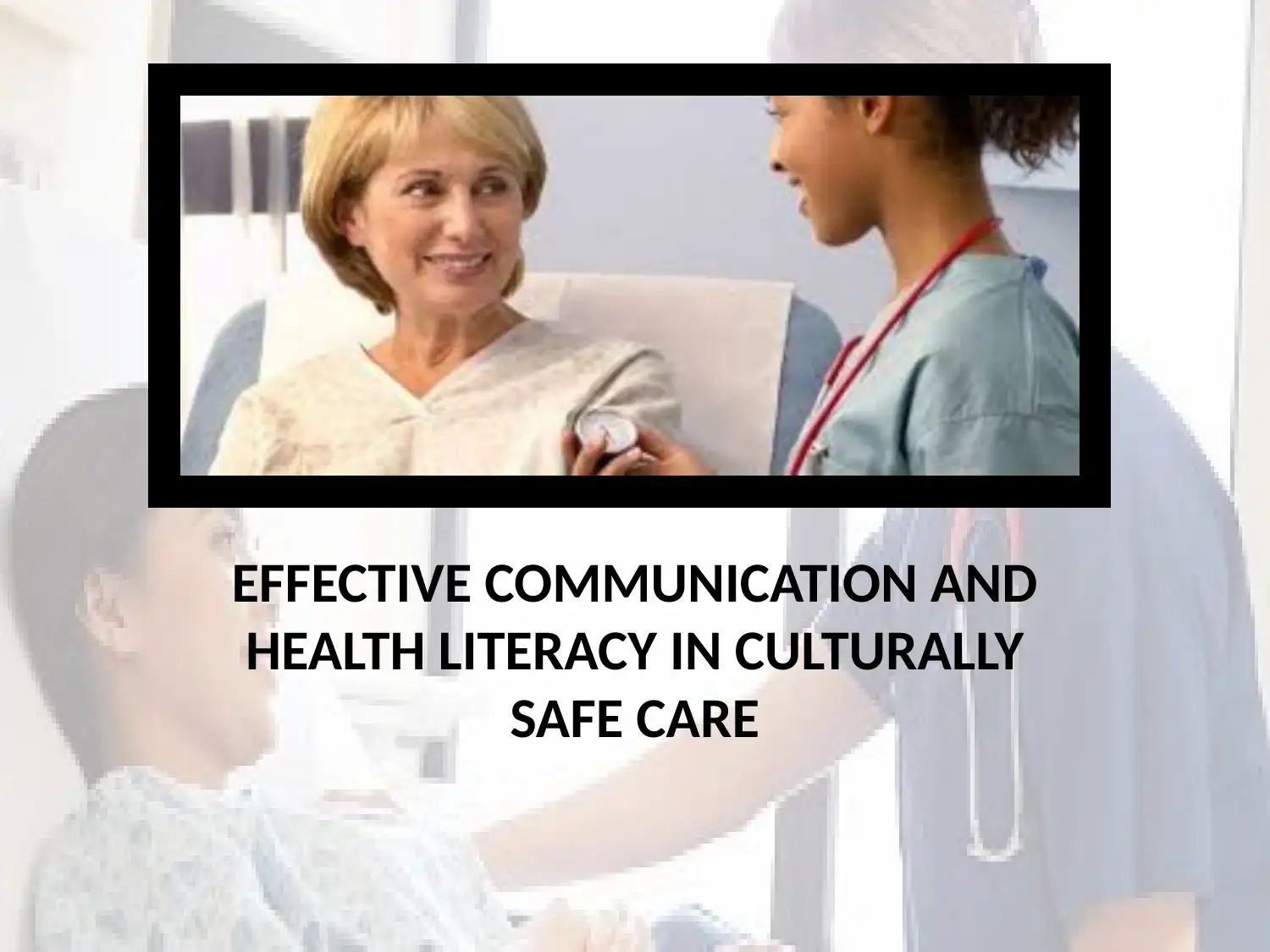
EFFECTIVE COMMUNICATION AND
HEALTH LITERACY IN CULTURALLY
SAFE CARE
HEALTH LITERACY IN CULTURALLY
SAFE CARE
Paraphrase This Document
Need a fresh take? Get an instant paraphrase of this document with our AI Paraphraser
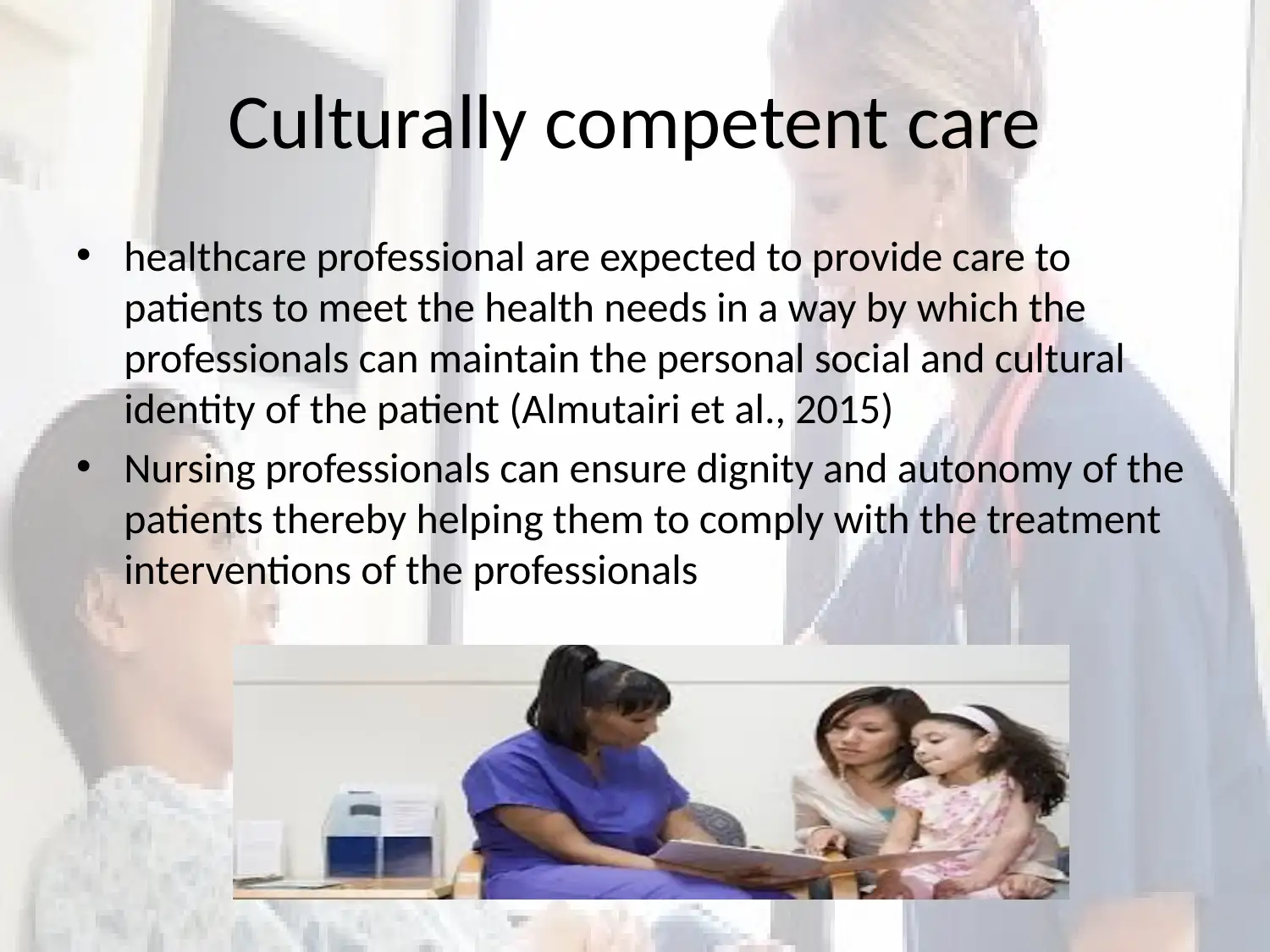
Culturally competent care
• healthcare professional are expected to provide care to
patients to meet the health needs in a way by which the
professionals can maintain the personal social and cultural
identity of the patient (Almutairi et al., 2015)
• Nursing professionals can ensure dignity and autonomy of the
patients thereby helping them to comply with the treatment
interventions of the professionals
• healthcare professional are expected to provide care to
patients to meet the health needs in a way by which the
professionals can maintain the personal social and cultural
identity of the patient (Almutairi et al., 2015)
• Nursing professionals can ensure dignity and autonomy of the
patients thereby helping them to comply with the treatment
interventions of the professionals
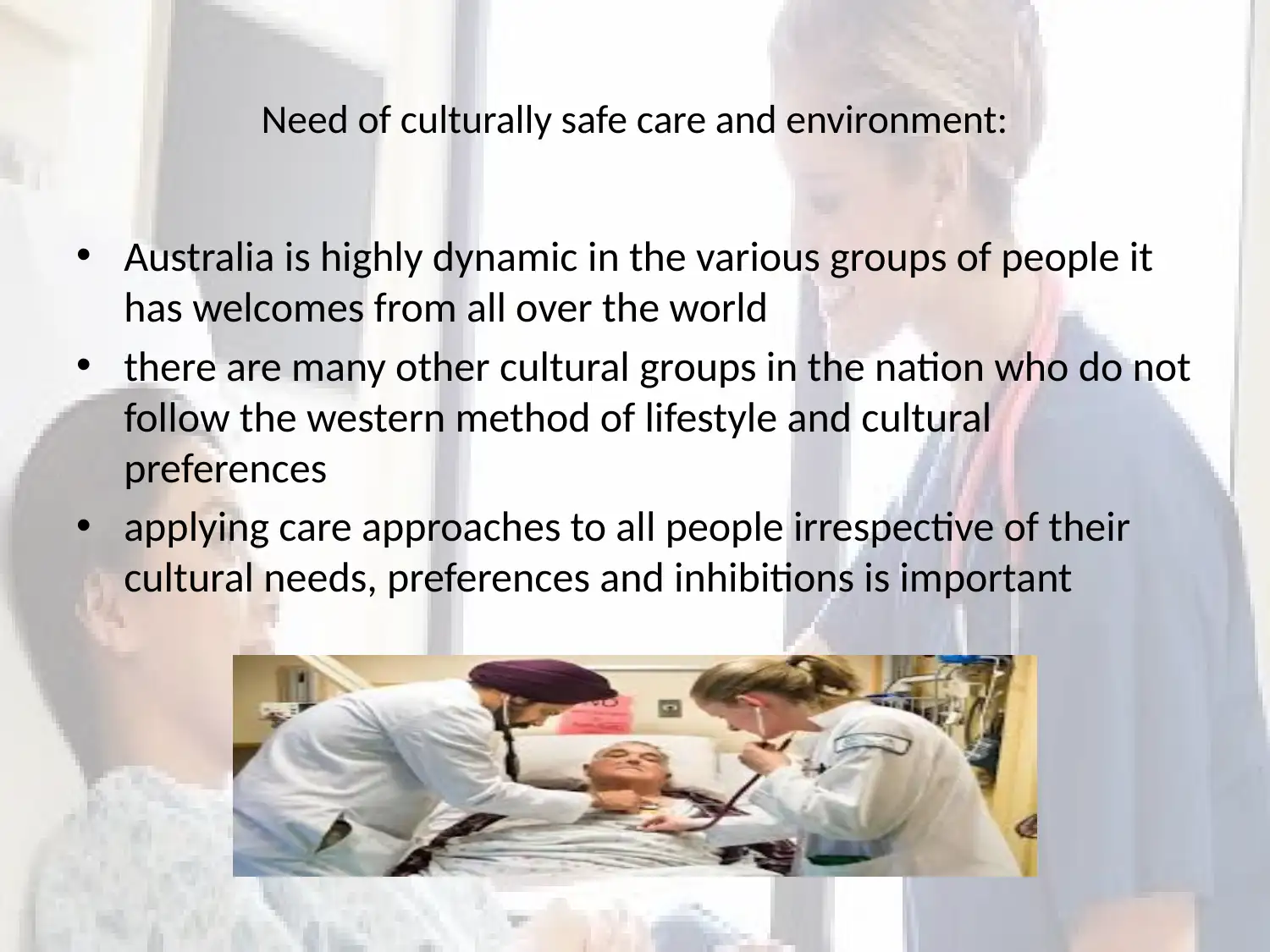
Need of culturally safe care and environment:
• Australia is highly dynamic in the various groups of people it
has welcomes from all over the world
• there are many other cultural groups in the nation who do not
follow the western method of lifestyle and cultural
preferences
• applying care approaches to all people irrespective of their
cultural needs, preferences and inhibitions is important
• Australia is highly dynamic in the various groups of people it
has welcomes from all over the world
• there are many other cultural groups in the nation who do not
follow the western method of lifestyle and cultural
preferences
• applying care approaches to all people irrespective of their
cultural needs, preferences and inhibitions is important
⊘ This is a preview!⊘
Do you want full access?
Subscribe today to unlock all pages.

Trusted by 1+ million students worldwide
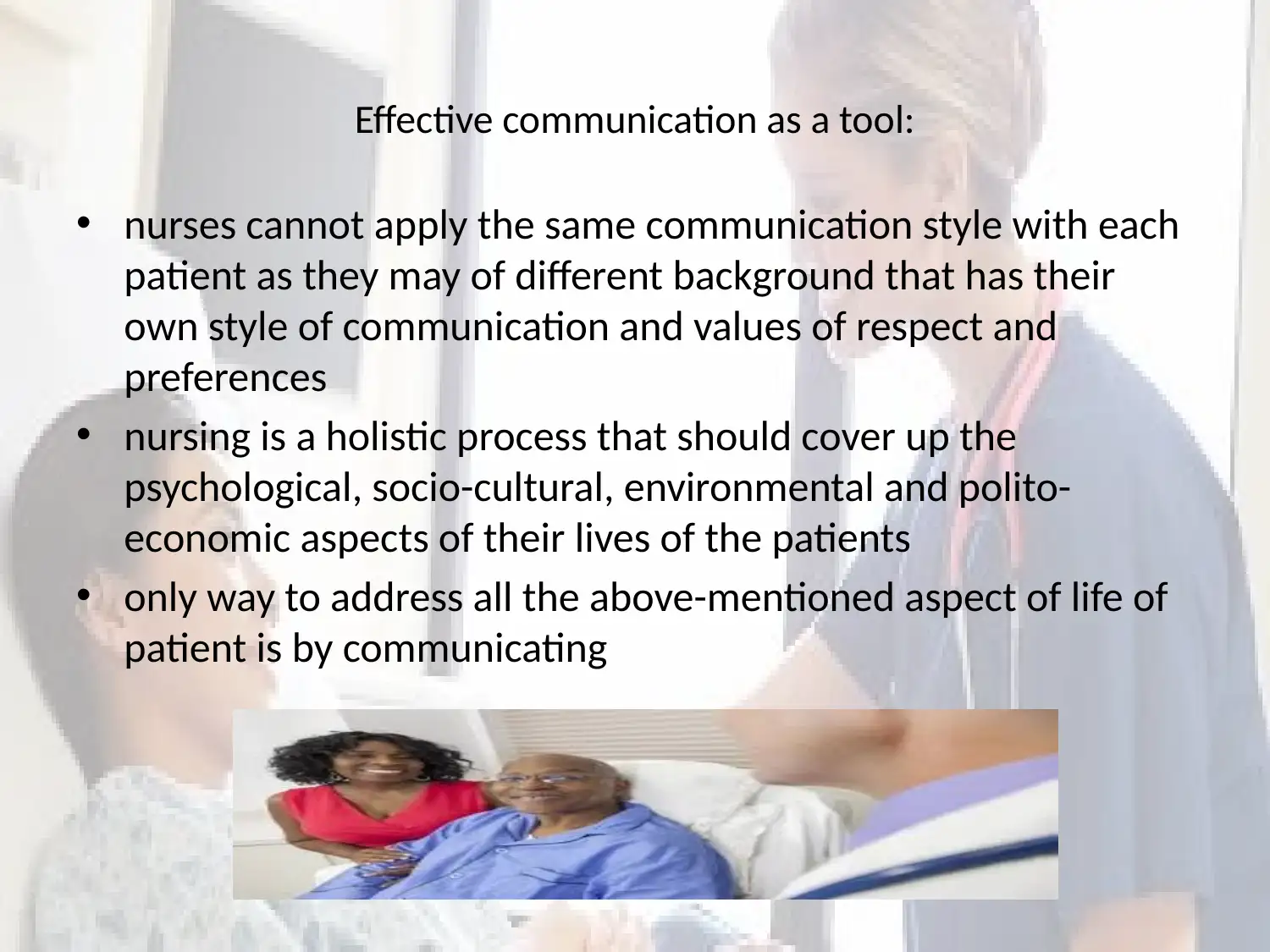
Effective communication as a tool:
• nurses cannot apply the same communication style with each
patient as they may of different background that has their
own style of communication and values of respect and
preferences
• nursing is a holistic process that should cover up the
psychological, socio-cultural, environmental and polito-
economic aspects of their lives of the patients
• only way to address all the above-mentioned aspect of life of
patient is by communicating
• nurses cannot apply the same communication style with each
patient as they may of different background that has their
own style of communication and values of respect and
preferences
• nursing is a holistic process that should cover up the
psychological, socio-cultural, environmental and polito-
economic aspects of their lives of the patients
• only way to address all the above-mentioned aspect of life of
patient is by communicating
Paraphrase This Document
Need a fresh take? Get an instant paraphrase of this document with our AI Paraphraser
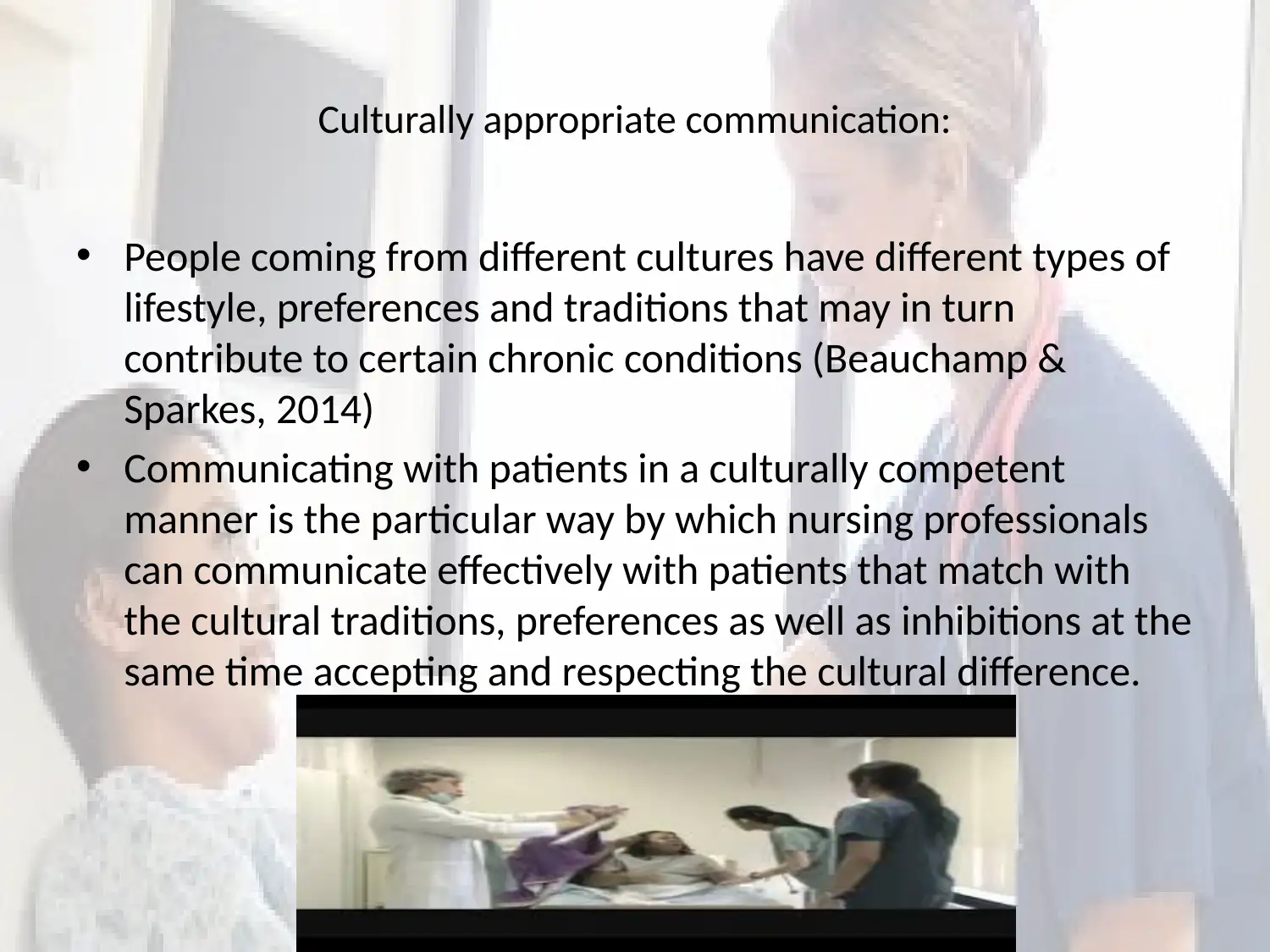
Culturally appropriate communication:
• People coming from different cultures have different types of
lifestyle, preferences and traditions that may in turn
contribute to certain chronic conditions (Beauchamp &
Sparkes, 2014)
• Communicating with patients in a culturally competent
manner is the particular way by which nursing professionals
can communicate effectively with patients that match with
the cultural traditions, preferences as well as inhibitions at the
same time accepting and respecting the cultural difference.
• People coming from different cultures have different types of
lifestyle, preferences and traditions that may in turn
contribute to certain chronic conditions (Beauchamp &
Sparkes, 2014)
• Communicating with patients in a culturally competent
manner is the particular way by which nursing professionals
can communicate effectively with patients that match with
the cultural traditions, preferences as well as inhibitions at the
same time accepting and respecting the cultural difference.
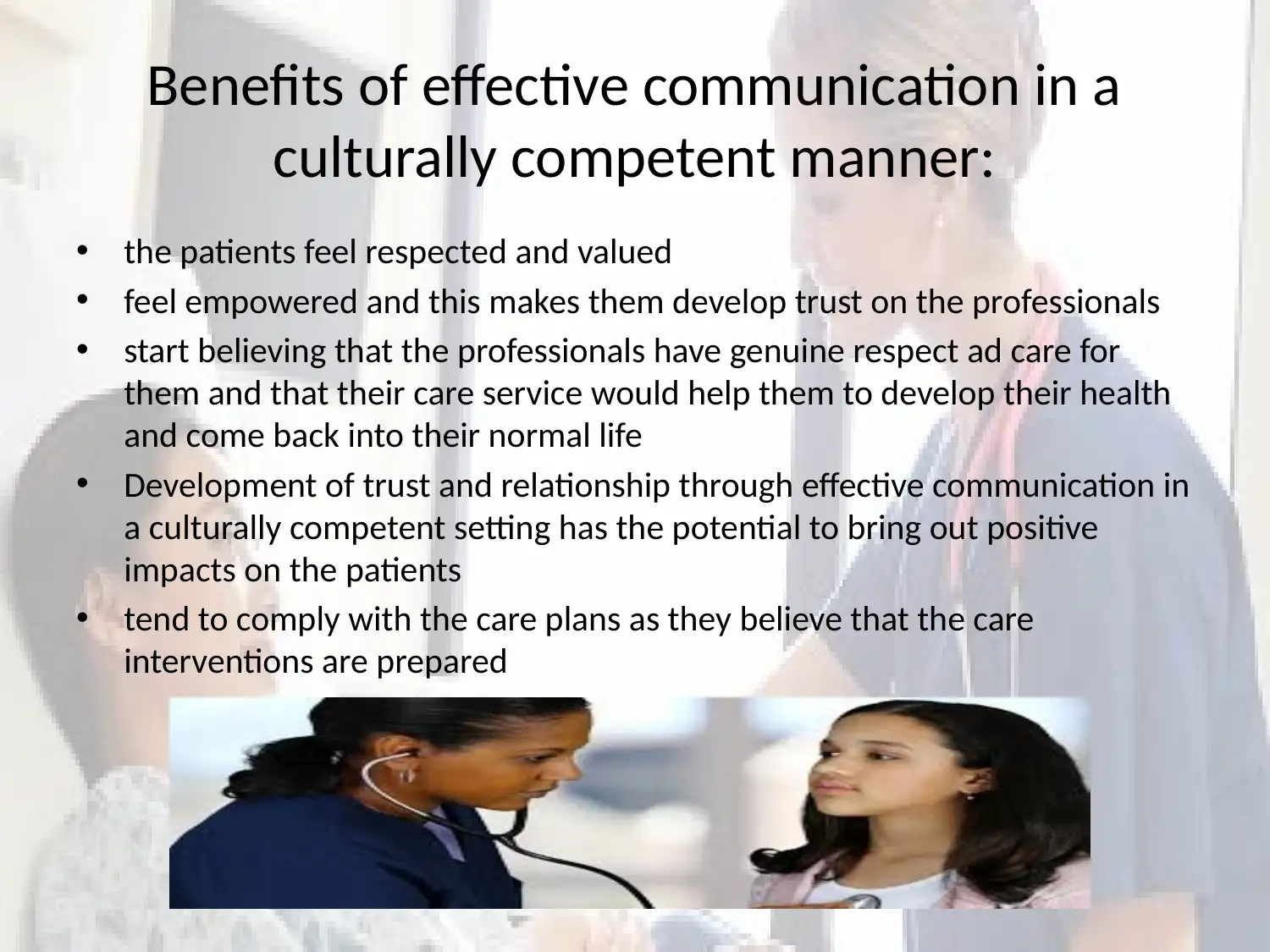
Benefits of effective communication in a
culturally competent manner:
• the patients feel respected and valued
• feel empowered and this makes them develop trust on the professionals
• start believing that the professionals have genuine respect ad care for
them and that their care service would help them to develop their health
and come back into their normal life
• Development of trust and relationship through effective communication in
a culturally competent setting has the potential to bring out positive
impacts on the patients
• tend to comply with the care plans as they believe that the care
interventions are prepared
culturally competent manner:
• the patients feel respected and valued
• feel empowered and this makes them develop trust on the professionals
• start believing that the professionals have genuine respect ad care for
them and that their care service would help them to develop their health
and come back into their normal life
• Development of trust and relationship through effective communication in
a culturally competent setting has the potential to bring out positive
impacts on the patients
• tend to comply with the care plans as they believe that the care
interventions are prepared
⊘ This is a preview!⊘
Do you want full access?
Subscribe today to unlock all pages.

Trusted by 1+ million students worldwide

Examples of non-verbal cues of communication:
• The body language exhibited by the nurse is one of the most
important powerful weapon by which the professionals can
establish effective relationship with the patients from
culturally competent background
• Eye contact is one of the most important nonverbal cues that
vary from one culture to another culture
• Another example can be provided as in case of the aboriginals
where they refer long silence in the midst of the conversation
procedures.
• The body language exhibited by the nurse is one of the most
important powerful weapon by which the professionals can
establish effective relationship with the patients from
culturally competent background
• Eye contact is one of the most important nonverbal cues that
vary from one culture to another culture
• Another example can be provided as in case of the aboriginals
where they refer long silence in the midst of the conversation
procedures.
Paraphrase This Document
Need a fresh take? Get an instant paraphrase of this document with our AI Paraphraser
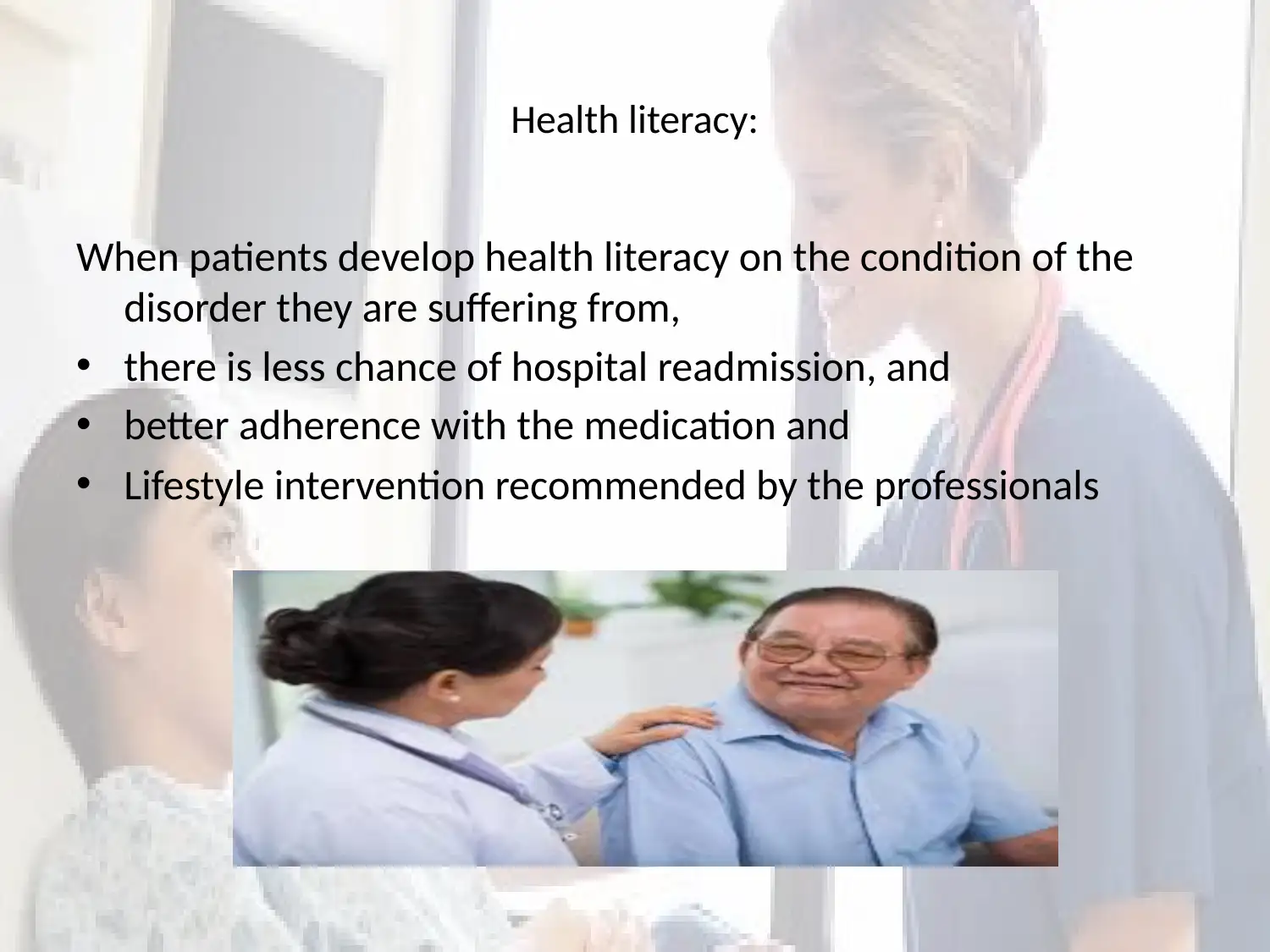
Health literacy:
When patients develop health literacy on the condition of the
disorder they are suffering from,
• there is less chance of hospital readmission, and
• better adherence with the medication and
• Lifestyle intervention recommended by the professionals
When patients develop health literacy on the condition of the
disorder they are suffering from,
• there is less chance of hospital readmission, and
• better adherence with the medication and
• Lifestyle intervention recommended by the professionals
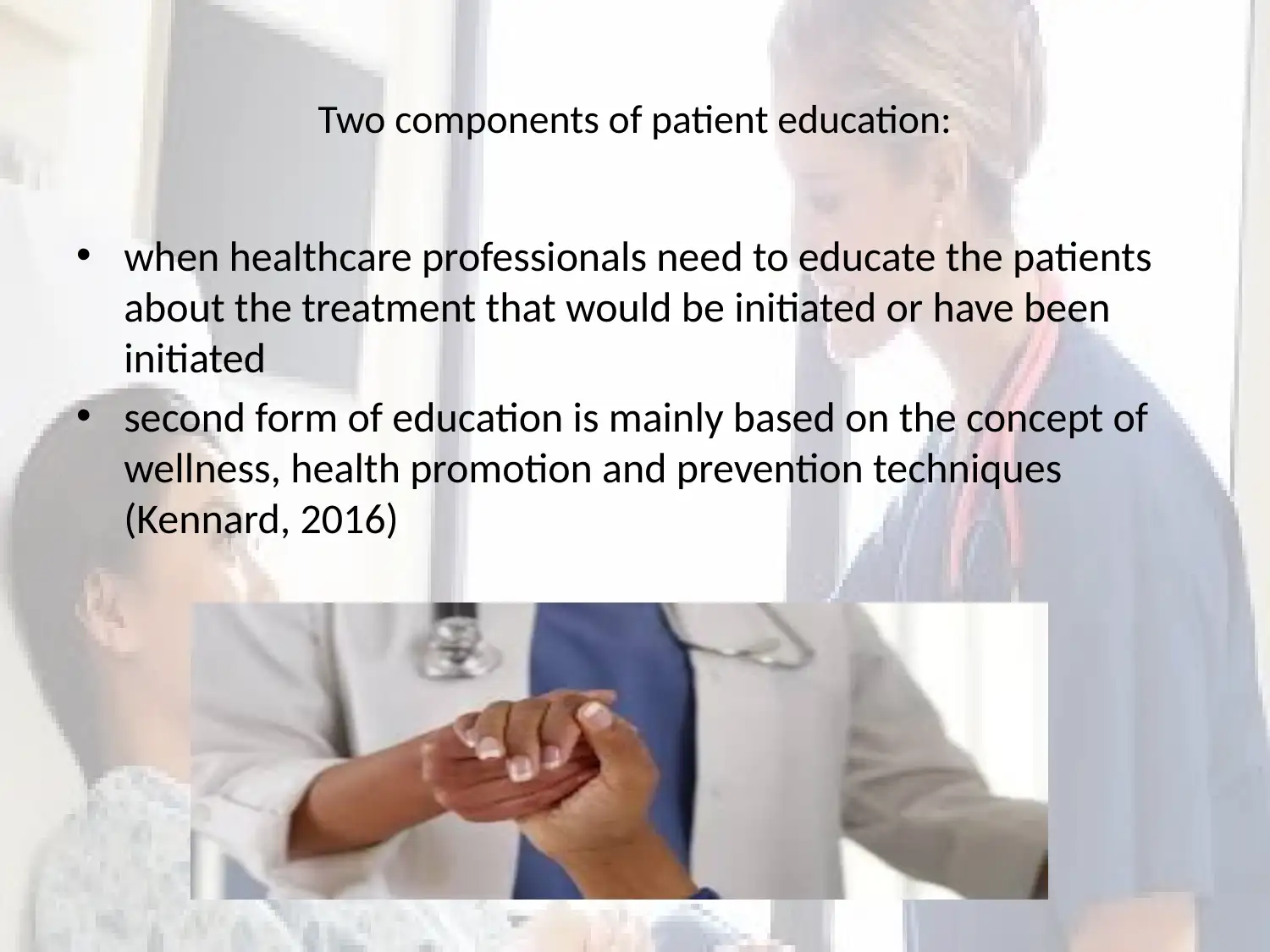
Two components of patient education:
• when healthcare professionals need to educate the patients
about the treatment that would be initiated or have been
initiated
• second form of education is mainly based on the concept of
wellness, health promotion and prevention techniques
(Kennard, 2016)
• when healthcare professionals need to educate the patients
about the treatment that would be initiated or have been
initiated
• second form of education is mainly based on the concept of
wellness, health promotion and prevention techniques
(Kennard, 2016)
⊘ This is a preview!⊘
Do you want full access?
Subscribe today to unlock all pages.

Trusted by 1+ million students worldwide
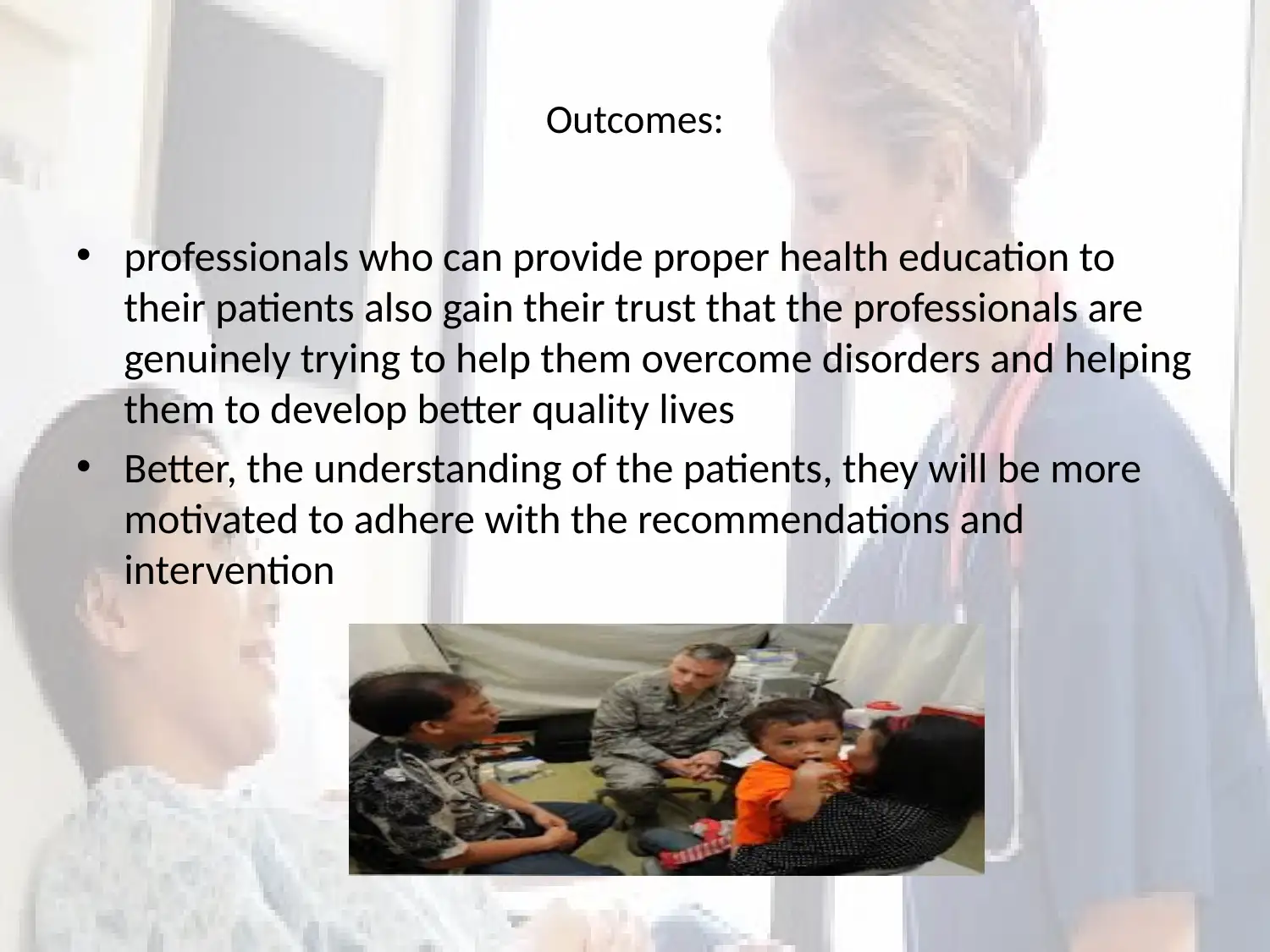
Outcomes:
• professionals who can provide proper health education to
their patients also gain their trust that the professionals are
genuinely trying to help them overcome disorders and helping
them to develop better quality lives
• Better, the understanding of the patients, they will be more
motivated to adhere with the recommendations and
intervention
• professionals who can provide proper health education to
their patients also gain their trust that the professionals are
genuinely trying to help them overcome disorders and helping
them to develop better quality lives
• Better, the understanding of the patients, they will be more
motivated to adhere with the recommendations and
intervention
Paraphrase This Document
Need a fresh take? Get an instant paraphrase of this document with our AI Paraphraser
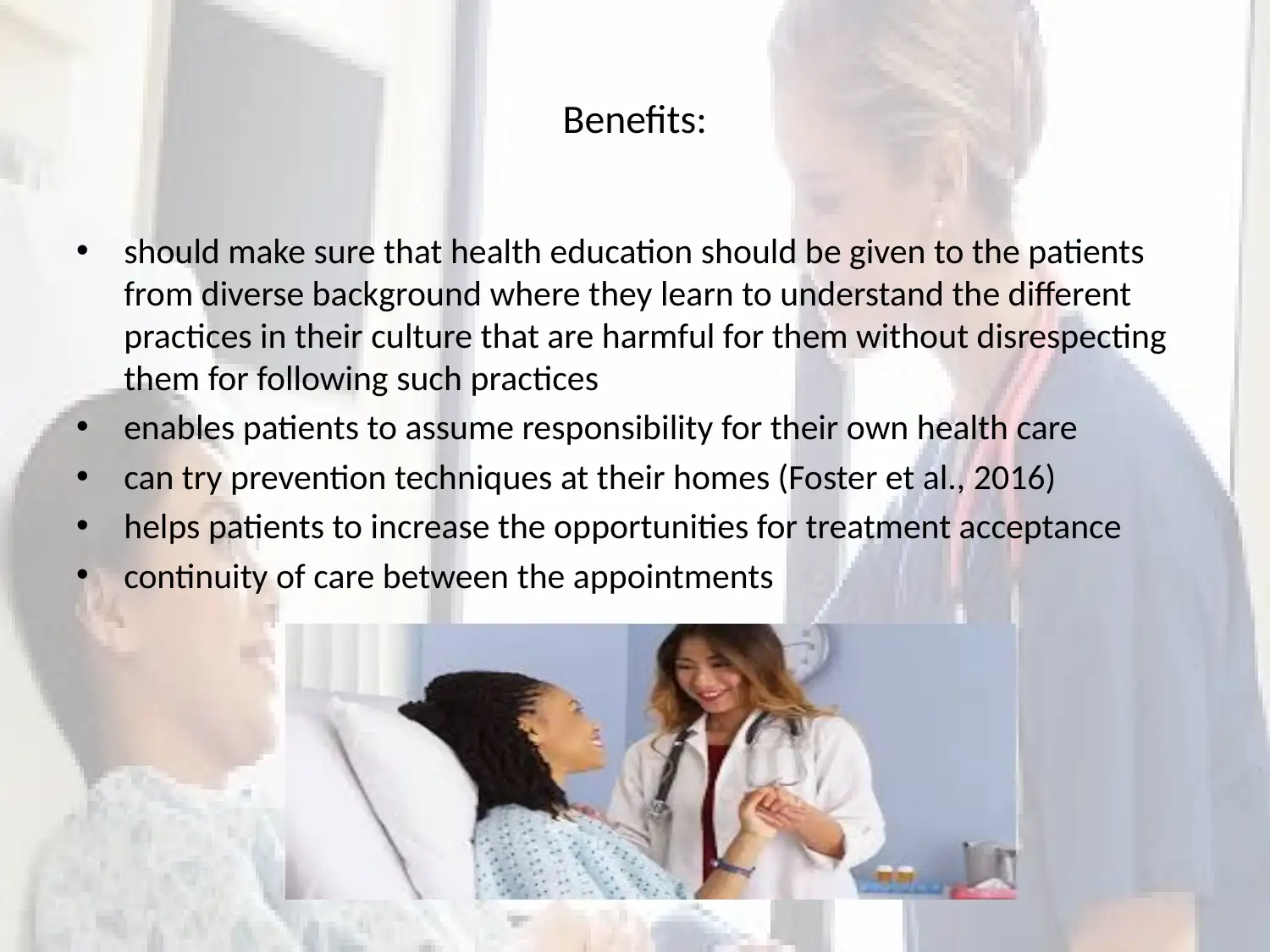
Benefits:
• should make sure that health education should be given to the patients
from diverse background where they learn to understand the different
practices in their culture that are harmful for them without disrespecting
them for following such practices
• enables patients to assume responsibility for their own health care
• can try prevention techniques at their homes (Foster et al., 2016)
• helps patients to increase the opportunities for treatment acceptance
• continuity of care between the appointments
• should make sure that health education should be given to the patients
from diverse background where they learn to understand the different
practices in their culture that are harmful for them without disrespecting
them for following such practices
• enables patients to assume responsibility for their own health care
• can try prevention techniques at their homes (Foster et al., 2016)
• helps patients to increase the opportunities for treatment acceptance
• continuity of care between the appointments
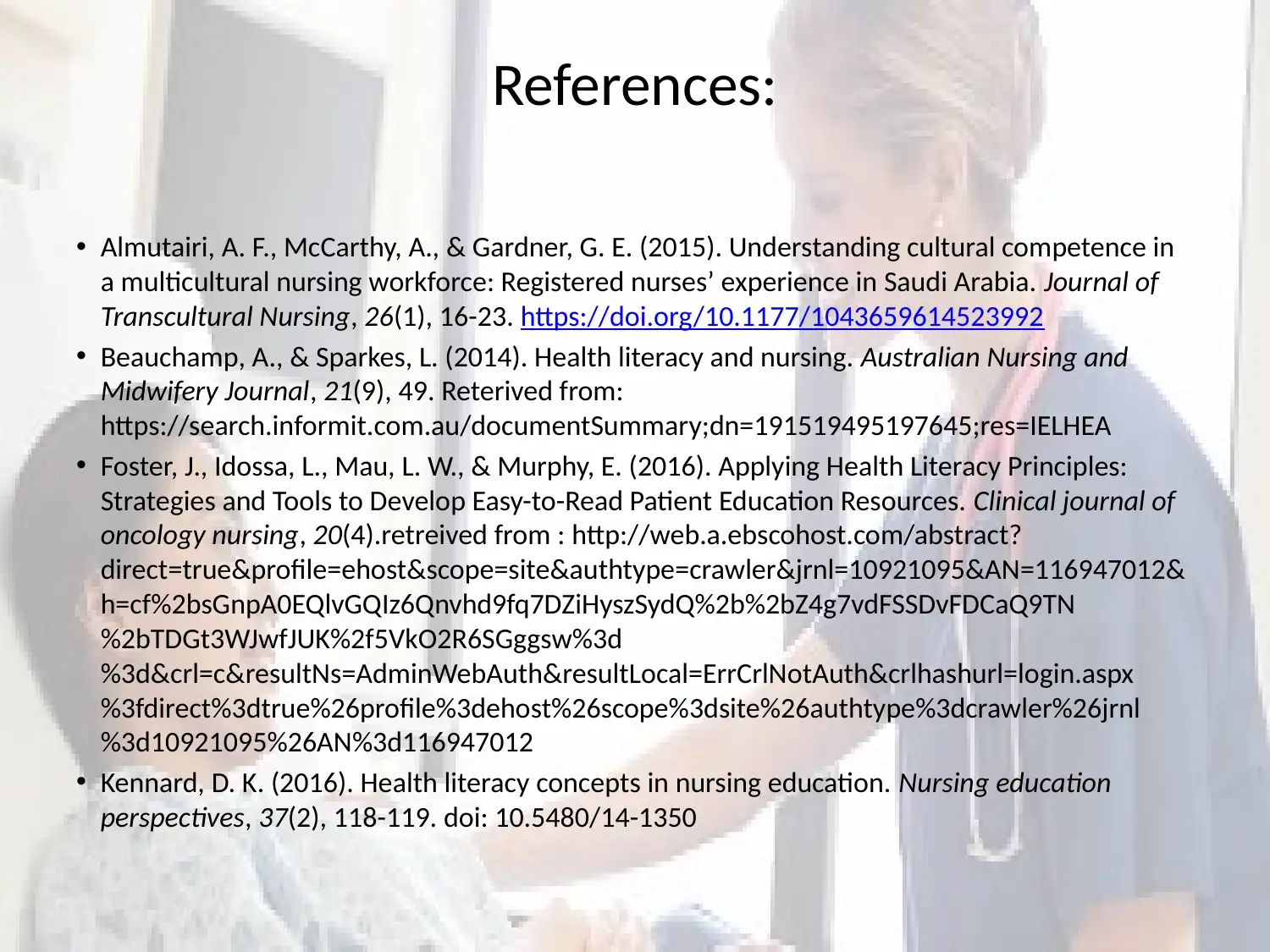
References:
• Almutairi, A. F., McCarthy, A., & Gardner, G. E. (2015). Understanding cultural competence in
a multicultural nursing workforce: Registered nurses’ experience in Saudi Arabia. Journal of
Transcultural Nursing, 26(1), 16-23. https://doi.org/10.1177/1043659614523992
• Beauchamp, A., & Sparkes, L. (2014). Health literacy and nursing. Australian Nursing and
Midwifery Journal, 21(9), 49. Reterived from:
https://search.informit.com.au/documentSummary;dn=191519495197645;res=IELHEA
• Foster, J., Idossa, L., Mau, L. W., & Murphy, E. (2016). Applying Health Literacy Principles:
Strategies and Tools to Develop Easy-to-Read Patient Education Resources. Clinical journal of
oncology nursing, 20(4).retreived from : http://web.a.ebscohost.com/abstract?
direct=true&profile=ehost&scope=site&authtype=crawler&jrnl=10921095&AN=116947012&
h=cf%2bsGnpA0EQlvGQIz6Qnvhd9fq7DZiHyszSydQ%2b%2bZ4g7vdFSSDvFDCaQ9TN
%2bTDGt3WJwfJUK%2f5VkO2R6SGggsw%3d
%3d&crl=c&resultNs=AdminWebAuth&resultLocal=ErrCrlNotAuth&crlhashurl=login.aspx
%3fdirect%3dtrue%26profile%3dehost%26scope%3dsite%26authtype%3dcrawler%26jrnl
%3d10921095%26AN%3d116947012
• Kennard, D. K. (2016). Health literacy concepts in nursing education. Nursing education
perspectives, 37(2), 118-119. doi: 10.5480/14-1350
• Almutairi, A. F., McCarthy, A., & Gardner, G. E. (2015). Understanding cultural competence in
a multicultural nursing workforce: Registered nurses’ experience in Saudi Arabia. Journal of
Transcultural Nursing, 26(1), 16-23. https://doi.org/10.1177/1043659614523992
• Beauchamp, A., & Sparkes, L. (2014). Health literacy and nursing. Australian Nursing and
Midwifery Journal, 21(9), 49. Reterived from:
https://search.informit.com.au/documentSummary;dn=191519495197645;res=IELHEA
• Foster, J., Idossa, L., Mau, L. W., & Murphy, E. (2016). Applying Health Literacy Principles:
Strategies and Tools to Develop Easy-to-Read Patient Education Resources. Clinical journal of
oncology nursing, 20(4).retreived from : http://web.a.ebscohost.com/abstract?
direct=true&profile=ehost&scope=site&authtype=crawler&jrnl=10921095&AN=116947012&
h=cf%2bsGnpA0EQlvGQIz6Qnvhd9fq7DZiHyszSydQ%2b%2bZ4g7vdFSSDvFDCaQ9TN
%2bTDGt3WJwfJUK%2f5VkO2R6SGggsw%3d
%3d&crl=c&resultNs=AdminWebAuth&resultLocal=ErrCrlNotAuth&crlhashurl=login.aspx
%3fdirect%3dtrue%26profile%3dehost%26scope%3dsite%26authtype%3dcrawler%26jrnl
%3d10921095%26AN%3d116947012
• Kennard, D. K. (2016). Health literacy concepts in nursing education. Nursing education
perspectives, 37(2), 118-119. doi: 10.5480/14-1350
⊘ This is a preview!⊘
Do you want full access?
Subscribe today to unlock all pages.

Trusted by 1+ million students worldwide
1 out of 13
Related Documents
Your All-in-One AI-Powered Toolkit for Academic Success.
+13062052269
info@desklib.com
Available 24*7 on WhatsApp / Email
![[object Object]](/_next/static/media/star-bottom.7253800d.svg)
Unlock your academic potential
Copyright © 2020–2025 A2Z Services. All Rights Reserved. Developed and managed by ZUCOL.





